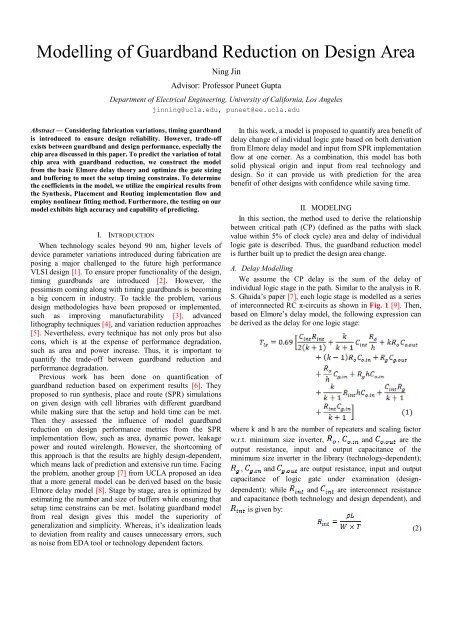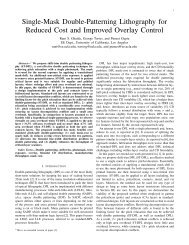IEEE Paper Template in A4 (V1) - UCLA
IEEE Paper Template in A4 (V1) - UCLA
IEEE Paper Template in A4 (V1) - UCLA
Create successful ePaper yourself
Turn your PDF publications into a flip-book with our unique Google optimized e-Paper software.
Modell<strong>in</strong>g of Guardband Reduction on Design Area<br />
N<strong>in</strong>g J<strong>in</strong><br />
Advisor: Professor Puneet Gupta<br />
Department of Electrical Eng<strong>in</strong>eer<strong>in</strong>g, University of California, Los Angeles<br />
j<strong>in</strong>n<strong>in</strong>g@ucla.edu, puneet@ee.ucla.edu<br />
Abstract — Consider<strong>in</strong>g fabrication variations, tim<strong>in</strong>g guardband<br />
is <strong>in</strong>troduced to ensure design reliability. However, trade-off<br />
exists between guardband and design performance, especially the<br />
chip area discussed <strong>in</strong> this paper. To predict the variation of total<br />
chip area with guardband reduction, we construct the model<br />
from the basic Elmore delay theory and optimize the gate siz<strong>in</strong>g<br />
and buffer<strong>in</strong>g to meet the setup tim<strong>in</strong>g constra<strong>in</strong>s. To determ<strong>in</strong>e<br />
the coefficients <strong>in</strong> the model, we utilize the empirical results from<br />
the Synthesis, Placement and Rout<strong>in</strong>g implementation flow and<br />
employ nonl<strong>in</strong>ear fitt<strong>in</strong>g method. Furthermore, the test<strong>in</strong>g on our<br />
model exhibits high accuracy and capability of predict<strong>in</strong>g.<br />
I. INTRODUCTION<br />
When technology scales beyond 90 nm, higher levels of<br />
device parameter variations <strong>in</strong>troduced dur<strong>in</strong>g fabrication are<br />
pos<strong>in</strong>g a major challenged to the future high performance<br />
VLSI design [1]. To ensure proper functionality of the design,<br />
tim<strong>in</strong>g guardbands are <strong>in</strong>troduced [2]. However, the<br />
pessimism com<strong>in</strong>g along with tim<strong>in</strong>g guardbands is becom<strong>in</strong>g<br />
a big concern <strong>in</strong> <strong>in</strong>dustry. To tackle the problem, various<br />
design methodologies have been proposed or implemented,<br />
such as improv<strong>in</strong>g manufacturability [3], advanced<br />
lithography techniques [4], and variation reduction approaches<br />
[5]. Nevertheless, every technique has not only pros but also<br />
cons, which is at the expense of performance degradation,<br />
such as area and power <strong>in</strong>crease. Thus, it is important to<br />
quantify the trade-off between guardband reduction and<br />
performance degradation.<br />
Previous work has been done on quantification of<br />
guardband reduction based on experiment results [6]. They<br />
proposed to run synthesis, place and route (SPR) simulations<br />
on given design with cell libraries with different guardband<br />
while mak<strong>in</strong>g sure that the setup and hold time can be met.<br />
Then they assessed the <strong>in</strong>fluence of model guardband<br />
reduction on design performance metrics from the SPR<br />
implementation flow, such as area, dynamic power, leakage<br />
power and routed wirelength. However, the shortcom<strong>in</strong>g of<br />
this approach is that the results are highly design-dependent,<br />
which means lack of prediction and extensive run time. Fac<strong>in</strong>g<br />
the problem, another group [7] from <strong>UCLA</strong> proposed an idea<br />
that a more general model can be derived based on the basic<br />
Elmore delay model [8]. Stage by stage, area is optimized by<br />
estimat<strong>in</strong>g the number and size of buffers while ensur<strong>in</strong>g that<br />
setup time constra<strong>in</strong>s can be met. Isolat<strong>in</strong>g guardband model<br />
from real design gives this model the superiority of<br />
generalization and simplicity. Whereas, it’s idealization leads<br />
to deviation from reality and causes unnecessary errors, such<br />
as noise from EDA tool or technology dependent factors.<br />
In this work, a model is proposed to quantify area benefit of<br />
delay change of <strong>in</strong>dividual logic gate based on both derivation<br />
from Elmore delay model and <strong>in</strong>put from SPR implementation<br />
flow at one corner. As a comb<strong>in</strong>ation, this model has both<br />
solid physical orig<strong>in</strong> and <strong>in</strong>put from real technology and<br />
design. So it can provide us with prediction for the area<br />
benefit of other designs with confidence while sav<strong>in</strong>g time.<br />
II. MODELING<br />
In this section, the method used to derive the relationship<br />
between critical path (CP) (def<strong>in</strong>ed as the paths with slack<br />
value with<strong>in</strong> 5% of clock cycle) area and delay of <strong>in</strong>dividual<br />
logic gate is described. Thus, the guardband reduction model<br />
is further built up to predict the design area change.<br />
A. Delay Modell<strong>in</strong>g<br />
We assume the CP delay is the sum of the delay of<br />
<strong>in</strong>dividual logic stage <strong>in</strong> the path. Similar to the analysis <strong>in</strong> R.<br />
S. Ghaida’s paper [7], each logic stage is modelled as a series<br />
of <strong>in</strong>terconnected RC π-circuits as shown <strong>in</strong> Fig. 1 [9]. Then,<br />
based on Elmore’s delay model, the follow<strong>in</strong>g expression can<br />
be derived as the delay for one logic stage:<br />
where k and h are the number of repeaters and scal<strong>in</strong>g factor<br />
w.r.t. m<strong>in</strong>imum size <strong>in</strong>verter, , and are the<br />
output resistance, <strong>in</strong>put and output capacitance of the<br />
m<strong>in</strong>imum size <strong>in</strong>verter <strong>in</strong> the library (technology-dependent);<br />
, and are output resistance, <strong>in</strong>put and output<br />
capacitance of logic gate under exam<strong>in</strong>ation (designdependent);<br />
while and are <strong>in</strong>terconnect resistance<br />
and capacitance (both technology and design dependent), and<br />
is given by:<br />
(2)
Fig. 1 Illustration of critical path delay model.<br />
where is the resistivity of copper, and and are<br />
<strong>in</strong>terconnect length, width and thickness respectively, which<br />
are shown <strong>in</strong> Fig. 2.<br />
For , the three-metal l<strong>in</strong>es and one-ground plane model<br />
is <strong>in</strong>troduced as illustrated <strong>in</strong> Fig. 2 [10].<br />
(3)<br />
where and are l<strong>in</strong>e-to-l<strong>in</strong>e and l<strong>in</strong>e-to-ground<br />
capacitances per length assum<strong>in</strong>g one-ground plane. And they<br />
are calculated us<strong>in</strong>g the empirical model from [10]:<br />
1) Siz<strong>in</strong>g of Logic Gates: Now, we assume that no buffer<br />
added, so k and h are fixed at 0 and 1 separately.<br />
Substitut<strong>in</strong>g k and h <strong>in</strong>to Eq. (1) gives:<br />
(6)<br />
To calculate the optimum siz<strong>in</strong>g factor, we take first<br />
order derivative of with regards to , notic<strong>in</strong>g the<br />
relationships below:<br />
Gate delay equation:<br />
Fanout equation:<br />
(7)<br />
(5)<br />
where S and H are the spac<strong>in</strong>g between l<strong>in</strong>es and height of<br />
l<strong>in</strong>es from ground separately, also as shown <strong>in</strong> Fig. 2 below.<br />
(4)<br />
(8)<br />
where F is the fanout load of the given logic gate, which is<br />
equal to the logic fanout by assum<strong>in</strong>g that all gates <strong>in</strong> CPs<br />
are of equal size; T gate is the delay of the logic gate. We<br />
use T gate value correspond<strong>in</strong>g to the m<strong>in</strong>imum <strong>in</strong>put signal<br />
slew and maximum C L for more accurate approximation of<br />
R g . S<strong>in</strong>ce T gate is provided for rise and fall transitions, we<br />
use the average value as approximation. The method we<br />
use to extract parameter T gate will be described <strong>in</strong> detail <strong>in</strong><br />
part III.<br />
Comb<strong>in</strong><strong>in</strong>g Eq. (7) and (8) gives:<br />
Tak<strong>in</strong>g first order derivative of R g with regards to C g,<strong>in</strong><br />
gives:<br />
(9)<br />
Fig. 2 Interconnect resistance and capacitance approximation model.<br />
Now, we assume that dur<strong>in</strong>g SPR, the automation tool takes<br />
two steps to meet the setup time requirement: first siz<strong>in</strong>g the<br />
orig<strong>in</strong>al logic gate and then add<strong>in</strong>g buffers <strong>in</strong>-between logic<br />
gates to further improve tim<strong>in</strong>g, which are shown below<br />
separately (experimental foundation can be seen <strong>in</strong> part IV):<br />
Now, we can get:<br />
(10)<br />
(11)
Sett<strong>in</strong>g Eq. (11) equal to zero gives:<br />
(12)<br />
where is the optimized <strong>in</strong>put capacitance of the<br />
logic gate consider<strong>in</strong>g setup time constra<strong>in</strong>s.<br />
2) Buffer<strong>in</strong>g Between Logic Gates: Similar to the<br />
previous method used to optimize the size of logic gates,<br />
we can further improve tim<strong>in</strong>g by add<strong>in</strong>g buffers of<br />
optimal number ( ) and scal<strong>in</strong>g factor ( ). By<br />
sett<strong>in</strong>g and to zero, and are calculated<br />
to be:<br />
where<br />
experiment results.<br />
<strong>in</strong>verter.<br />
For<br />
(15)<br />
are coefficients to be fitted from the<br />
is the area of m<strong>in</strong>imum size<br />
, first of all we calculate the average<br />
of all the gates <strong>in</strong> CPs at the slowest gate delay<br />
library based on Eq. (12) and then sum up among all stages<br />
<strong>in</strong> CPs. The reason why we pick the <strong>in</strong>put from the slowest<br />
corner is that it can make sure that all CPs needed to be<br />
considered are <strong>in</strong>cluded dur<strong>in</strong>g the modell<strong>in</strong>g. The<br />
def<strong>in</strong>ition of each parameter is summarized <strong>in</strong> Form 1<br />
below:<br />
Symbol<br />
F<br />
R o<br />
C o,<strong>in</strong><br />
R <strong>in</strong>t<br />
FORM I<br />
PARAMETER DEFINATION<br />
Def<strong>in</strong>ition<br />
Average logic fanout of all the <strong>in</strong>stances <strong>in</strong> CPs<br />
Output resistance of m<strong>in</strong>imum size <strong>in</strong>verter<br />
Average <strong>in</strong>put capacitance of m<strong>in</strong>imum size<br />
<strong>in</strong>verter<br />
Average resistance of <strong>in</strong>terconnect wires<br />
C <strong>in</strong>t Interconnect capacitance [11]<br />
C unit<br />
T gate<br />
Unit capacitance per area<br />
Average gate delay of all <strong>in</strong>stances <strong>in</strong> CPs<br />
(13)<br />
(14)<br />
Specifically,<br />
, where S is the<br />
scal<strong>in</strong>g factor of delay change and is the scal<strong>in</strong>g<br />
factor of the slowest corner with positive slack for specific<br />
clock period (will be expla<strong>in</strong>ed more <strong>in</strong> part III).<br />
For<br />
, it is calculated <strong>in</strong> a similar way as<br />
that of mentioned above.<br />
Substitut<strong>in</strong>g Eq. (12)-(14) <strong>in</strong>to (15), we have<br />
Eq. (13) and (14) are calculated for all the CPs <strong>in</strong> the<br />
design to optimize delay of each logic stage and meet<br />
setup time requirement. After that, area of CPs can be<br />
estimated as a function of as follow<strong>in</strong>g.<br />
B. Area Modell<strong>in</strong>g<br />
1) Modell<strong>in</strong>g of CP Area vs. Gate Delay: Based on the<br />
two parts mentioned above, we can model the area of CP<br />
vs. gate delay as:<br />
(16)<br />
where is number of <strong>in</strong>stances <strong>in</strong> all CPs at the slowest<br />
corner. In Eq. (16), CP area is implicitly expressed as a
function of and . Because<br />
and<br />
are all <strong>in</strong>put data from<br />
experiments at the slowest corner, now we successfully<br />
model CP area vs. the delay of <strong>in</strong>dividual logic gate.<br />
To further <strong>in</strong>vestigate the relationship between A CP and<br />
S, we can expand Eq. (16) by <strong>in</strong>sert<strong>in</strong>g the expression of<br />
R o , R <strong>in</strong>t , C <strong>in</strong>t and T gate :<br />
(<br />
17)<br />
where and are given by Eq. (12) and (13):<br />
(18)<br />
(19)<br />
Thus, we have the full relationship between A CP and S.<br />
III. IMPLEMENTATION FLOW AND TESTCASES<br />
A. Liberty Model Scal<strong>in</strong>g<br />
In our experiments, ARM 45nm 12S SOI standard-cell<br />
library is used at the P/V/T corner of ss/0.9V/-40C with<br />
maximum history effect, nom<strong>in</strong>al extraction and maximum<br />
overlay. To simplify the problem, we model the effect of<br />
delay change <strong>in</strong>stead of actual guardband reduction because<br />
guardband reduction is equivalent to keep<strong>in</strong>g one corner fixed<br />
while chang<strong>in</strong>g the delay <strong>in</strong> the other library corner. So,<br />
start<strong>in</strong>g from the orig<strong>in</strong>al library, we scale the cell delay value<br />
<strong>in</strong> the library by a factor from 0.5 up to 1.4 and get 9 new<br />
library corners. Then the parameter is modelled as<br />
, where is the average gate<br />
delay of the design at the slowest possible library corner for<br />
given clock cycle, is the scal<strong>in</strong>g factor of the slowest<br />
possible library corner with positive slack and is the scal<strong>in</strong>g<br />
factor with the range of from 0.5 to .<br />
B. Tim<strong>in</strong>g-driven Implementation Flow<br />
Fig. 3 illustrates the tim<strong>in</strong>g-driven SPR implementation<br />
flow used <strong>in</strong> our experiments. We start from the RTL codes of<br />
the design, do physical-driven synthesis with 9 library corners<br />
<strong>in</strong> parallel. Based on the results from synthesis, we execute the<br />
physical design steps with four rout<strong>in</strong>g layers and check<br />
tim<strong>in</strong>g at each step. At the event of tim<strong>in</strong>g violations, tim<strong>in</strong>g<br />
optimization will be performed to ensure setup time constra<strong>in</strong>s<br />
are met. Because <strong>in</strong> the synthesis stage, different library<br />
corners are used, gate level netlists are generated with<br />
different total standard-cell areas. In that case, to get the best<br />
utilization ratio, iteration over the entire physical design steps<br />
is implemented until zero DRC error is ensured.<br />
2) Modell<strong>in</strong>g of Chip Area vs. Gate Delay: Now, we<br />
assume that when we scale the library from the slowest<br />
corner to faster ones, the chip area change only comes<br />
from area change of CPs (siz<strong>in</strong>g and buffer<strong>in</strong>g), while the<br />
non-CPs area is kept unchanged. So <strong>in</strong> that case, we have<br />
the relationship<br />
(20)<br />
where is the total chip area after SPR, is the total<br />
chip area at the slowest library corner, is the CP area<br />
from Eq. (17) and is the CP area from Eq. (17) with<br />
S = 1.4.<br />
Divid<strong>in</strong>g both sides of Eq. (20) by , we have<br />
(21)<br />
By substitut<strong>in</strong>g Eq. (19) <strong>in</strong> to Eq. (21), we will have the<br />
relationship between and scal<strong>in</strong>g factor (which is<br />
<strong>in</strong>side ), while all the other parameters are from the<br />
experiment results at the slowest library corner.<br />
Fig. 3 Tim<strong>in</strong>g-driven SPR Implementation Flow.<br />
C. Testcases and Tools<br />
In our experiments, five benchmark designs are taken to run<br />
through the flow, which are ae18, mips, spi, tv80 and usb<br />
obta<strong>in</strong>ed from the open-source site opencores.org [12]. Three
of them (ae18, tv80 and spi) are taken to fit the coefficients <strong>in</strong><br />
the model, while the other two (usb and ae18) are used to<br />
verify the accuracy of the model. The design description,<br />
approximate number of <strong>in</strong>stances <strong>in</strong> each design and the clock<br />
period used <strong>in</strong> synthesis ( ) and place and route ( ) are<br />
shown <strong>in</strong> Table 1. The rule of thumb to pick the clock period<br />
is to make sure that the tim<strong>in</strong>g slack is positive at the slowest<br />
library corner while the slack is not too large at the faster<br />
corners, <strong>in</strong> which case the data from different library corners<br />
can be comparable.<br />
TABLE I<br />
DESCRIPTION OF THE BENCHMARKS USED IN THE EXPERIMENT<br />
ae18<br />
mips<br />
Design Description<br />
Clean room implementation<br />
of the Microchip PIC18<br />
series CPU core<br />
Soft processor core with<br />
five pipel<strong>in</strong>e stages<br />
# of total<br />
<strong>in</strong>stances (ps) (ps)<br />
~4,000 1000 1000<br />
~7,600 800 800<br />
spi SPI IP ~1,300 500 500<br />
tv80 TV80 8-Bit Microprocessor ~2,800 800 700<br />
Core<br />
usb USB function core ~6,000 550 500<br />
The EDA tools used <strong>in</strong> our experiments <strong>in</strong>clude Blaze<br />
v2010.1.0 for library scal<strong>in</strong>g, Cadence RTL Compiler for<br />
synthesis and Cadence SOC Encounter to execute physical<br />
design flow.<br />
IV. EXPERIMENT RESULTS AND DISCUSSION<br />
In our experiments, for all five testcases (ae18, mips, spi,<br />
tv80 and usb), we run the entire SPR implementation flow<br />
with 9 library corners of scal<strong>in</strong>g factor from 0.5 to 1.4. So, <strong>in</strong><br />
total, we have<br />
sets of SPR runs.<br />
A. Empirical Analysis of Chip Area Change<br />
From the synthesis results, the total design area is<br />
decomposed <strong>in</strong>to three categories: area of buffers and<br />
<strong>in</strong>verters, area of comb<strong>in</strong>ational logic (CL) and sequential<br />
logic (SL), while the <strong>in</strong>terconnect area is not considered at this<br />
stage of study. To <strong>in</strong>vestigate the orig<strong>in</strong> of the total design<br />
area change, the contribution and variation tendency of each<br />
part are plotted <strong>in</strong> Fig. 4 below as histogram.<br />
Fig. 4 Histogram of area contribution of 5 designs.
From Fig. 4, it can be seen that the total area change mostly<br />
comes from the area change of CL and <strong>in</strong>verter and buffer,<br />
while SL area change can be reasonably ignored. Thus the<br />
experiment results support the assumptions and model built up<br />
as described <strong>in</strong> part II.<br />
B. Impact of Gate Delay on Design Area<br />
Based on the implementation flow described <strong>in</strong> Part III, we<br />
can obta<strong>in</strong> the total chip area from Encounter after SPR<br />
correspond<strong>in</strong>g to 9 library corners and 5 designs except design<br />
spi, the slowest corner of which is at scal<strong>in</strong>g factor equals 1.35<br />
so we have 8 corners for that design.<br />
Fig. 5 and Fig. 6 below show the plot of the normalized (by<br />
chip area at the slowest library corner A o ) total area versus<br />
gate delay scal<strong>in</strong>g factor S from synthesis and SPR<br />
implementation flow separately. For synthesis, only data with<br />
zero slack are considered valid and we normalize the total area<br />
by the one at the nom<strong>in</strong>al corner, which means synthesis at the<br />
orig<strong>in</strong>al library.<br />
<strong>in</strong>dividual gate delay <strong>in</strong>creases, the tool will automatically do<br />
siz<strong>in</strong>g and buffer<strong>in</strong>g to help improve tim<strong>in</strong>g and fix setup<br />
violations. However, it does not necessarily size the gates up<br />
because sometimes smaller gates help with tim<strong>in</strong>g as well,<br />
which <strong>in</strong>terprets the “noise” obseved <strong>in</strong> the plot.<br />
C. Mathematical Pre-Model<strong>in</strong>g<br />
First of all, from observation of the curves <strong>in</strong> Fig. 5, we<br />
notice that roughly the normalized total area <strong>in</strong>creases<br />
exponentially with gate delay. So, mathematically, we fit the<br />
experiment data to see the possibility of model<strong>in</strong>g. To<br />
simplify the problem, we use only one parameter from the<br />
synthesis results to count for the difference of designs, which<br />
is the CPs area at the nom<strong>in</strong>al library corner (named CPA).<br />
We assume that the model can be <strong>in</strong> two forms:<br />
(22)<br />
(23)<br />
where a 1 , a 2 , a 3 , b 1 , b 2 and b 3 are coefficients to be fitted from<br />
the experiment results; m, n, p and q are the exponents to be<br />
optimized by test<strong>in</strong>g. In this work, Newton method is applied<br />
to f<strong>in</strong>d the best nonl<strong>in</strong>ear models, which are<br />
(24)<br />
(25)<br />
Here, designs ae18, mips and usb are used to fit the<br />
coefficients while the model is tested by spi and tv80. The<br />
fitt<strong>in</strong>g curves are shown below:<br />
Fig. 5 Total chip area versus scal<strong>in</strong>g factor of gate delay (from synthesis).<br />
Fig. 6 Total chip area versus scal<strong>in</strong>g factor of gate delay (from SPR).<br />
It is obvious that when the scal<strong>in</strong>g factor <strong>in</strong>creases, which<br />
means the gate delay <strong>in</strong> the standard-cell library <strong>in</strong>creases, the<br />
total chip area <strong>in</strong>creases too if we ignore the noise obseved<br />
from the EDA tool. It can be expla<strong>in</strong>ed that when the
Fig. 7 Mathematical model fitt<strong>in</strong>g.<br />
From Fig. 7, it can be seen that this simplified mathematical<br />
model roughly shows the trend of the area change, which<br />
projects the possibility of model<strong>in</strong>g from physical derivations.<br />
D. Physical Model<br />
Now, guardband model can be built based on the derivation<br />
from part II. As the model is dependent on data <strong>in</strong>put<br />
( and ) from the slowest corner, we<br />
summarize all those parameters for five designs <strong>in</strong> Table 2<br />
shown below.<br />
TABLE II<br />
PARAMETERS AT SLOWEST LIBRARY CORNER<br />
ae18 0.1685e-9 4.2054 0.9218e-6 367 1.40<br />
mips 0.1656e-9 4.2965 0.8567e-6 357 1.40<br />
spi 0.1636e-9 3.5800 0.5853e-6 494 1.35<br />
tv80 0.1753e-9 2.9372 0.5269e-6 656 1.40<br />
usb 0.1674e-9 4.2870 0.8406e-6 320 1.40<br />
To figure out the three coefficients <strong>in</strong> the model (Eq. (19)),<br />
we selected data from ae18, tv80 and spi and applied the<br />
nonl<strong>in</strong>ear fitt<strong>in</strong>g method. The nonl<strong>in</strong>ear method used is<br />
"nl<strong>in</strong>fit" function <strong>in</strong> Matlab, which is implemented based on<br />
Levenberg-Marquardt algorithm [13]. Levenberg-Marquardt<br />
algorithm is an iterative technique that locates the m<strong>in</strong>imum of<br />
a function that can be expressed as the sum of squares of<br />
nonl<strong>in</strong>ear functions. This method can also be viewed as a<br />
comb<strong>in</strong>ation of steepest descent and Gauss-Newton method<br />
and has become a standard technique for solv<strong>in</strong>g nonl<strong>in</strong>ear<br />
least-squares problems. The term<strong>in</strong>ation tolerance is fixed at<br />
1e-8 <strong>in</strong> this case.<br />
In addition, roubust option is added, which means it<br />
iteratively refits a weighted nonl<strong>in</strong>ear regression, where the<br />
weights at each iteration are based on each observation's<br />
residual from the previous iteration. In other word,at each<br />
iteration the nonl<strong>in</strong>ear regression is a weighted version of the<br />
Levenberg-Marquardt algorithm which "nl<strong>in</strong>fit" uses for nonrobust<br />
fits.
Based on the nonl<strong>in</strong>ear fitt<strong>in</strong>g method presented above, the<br />
three coefficients c 1 , c 2 , and c 3 are calculated to be -2.4870e3,<br />
-0.0608e3 and -0.2420e3 m 2 respectively.<br />
Fig. 8 below exhibits the comparison between the fitt<strong>in</strong>g<br />
curves and experiment data po<strong>in</strong>ts:<br />
Fig. 9 Test<strong>in</strong>g of the fitted model.<br />
From the above figures, it can be concluded that the fitted<br />
model based on siz<strong>in</strong>g and buffer<strong>in</strong>g theory has a good<br />
prediction for the trend of normalized total chip area change<br />
with gate delay scal<strong>in</strong>g upon <strong>in</strong>formation at one corner. This<br />
model comb<strong>in</strong>es physical theory with real experiment results,<br />
which provides a robust and time-efficient reference for<br />
guardband reduction dur<strong>in</strong>g design stage.<br />
Fig. 8 Comparison between the fitt<strong>in</strong>g model and experiment results.<br />
After gett<strong>in</strong>g the three coefficients from the three designs,<br />
we use the other two designs (usb and mips) to verify the<br />
accuracy of the model, which is shown <strong>in</strong> Fig. 9 as follow<strong>in</strong>g:<br />
V. CONCLUSIONS<br />
In this paper, a mathematical model is established to predict<br />
the chip area change with the scal<strong>in</strong>g of the gate delay <strong>in</strong> the<br />
standard-cell library. From the model<strong>in</strong>g perspective of view,<br />
we start from the most classical Elmore delay theory, optimize<br />
the gate size, buffer size and number step by step and f<strong>in</strong>ally<br />
arrive at a model relat<strong>in</strong>g chip area to the gate delay scal<strong>in</strong>g<br />
factor. However, this model is not totally isolated from real<br />
design characteristics. Design-dependent parameters from the<br />
SPR implementation flow are <strong>in</strong>troduced to consider the<br />
variation among different designs, which makes it more<br />
comprehensive than previous works.<br />
REFERENCES<br />
[1] Bowman, K., et al. 2002. “Impact of die-to-die and with<strong>in</strong>-die<br />
parameter fluctuation on the maximum clock frequency distribution for
gigascale <strong>in</strong>tegration,” <strong>IEEE</strong> Journal of Solid-State Circuits, vol. 37,<br />
pp.183-190, Feb 2002.<br />
[2] S.R. Nassif, “Model<strong>in</strong>g and forecast<strong>in</strong>g of manufactur<strong>in</strong>g variations,”<br />
International Workshop on Statistical Metrology, pp.2-10, 2000.<br />
[3] F. Worm, P. Thiran, G. de Micheli, P. Ienne, “Self-calibrat<strong>in</strong>g<br />
networks-on-chip,” <strong>IEEE</strong> International Symposium on Circuits and<br />
Systems (ISCAS), vol. 3, pp. 2361-2364, 23-26, May 2005.<br />
[4] M. C. Smayl<strong>in</strong>g et al, “Low k1 Logic Design us<strong>in</strong>g Gridded Design<br />
Rules,” SPIE, 2008.<br />
[5] P. Gupta, A. B. Kahng, Y. Kim and D. Sylvester, “Self-Compensat<strong>in</strong>g<br />
Design for Reduction of Tim<strong>in</strong>g and Leakage Sensitivity to Systematic<br />
Pattern Dependent Variation,” <strong>IEEE</strong> Transactions on CAD, 2007.<br />
[6] K. Jeong, A. B. Kahng and K. Samadi, “Impact of Guardband<br />
Reduction On Design Outcomes: A Quantitative Approach,” <strong>IEEE</strong><br />
Transaction on Semiconductor Manufactur<strong>in</strong>g, vol. 22, no. 4, Nov.<br />
2009.<br />
[7] R. S. Ghaida, “Area Benefit of Guardband-Reduction.”<br />
[8] W. C. Elmore, “The Transient Response of Damped L<strong>in</strong>ear Networks<br />
With Particular Regard to Wideband Amplifiers,” Journal of Applied<br />
Physics, vol 19, 55,<br />
[9] H. B. Bakoglu and J. D. Me<strong>in</strong>dl “Optimal <strong>in</strong>terconnection circuits for<br />
VLSI,” <strong>IEEE</strong> Trans. Electron Devices, vol. ED-32, no. 5, May 1985.<br />
[10] J. Chern, J. Huang, L. Arledge, P. Li, and P. Yang, “Multilevel metal<br />
capacitance models for CAD design synthesis systems,” <strong>IEEE</strong> Electron<br />
Device Letters, vol. 13, no. 1, January 1992.<br />
[11] International Technology Roadmap for Semiconductors [Onl<strong>in</strong>e].<br />
Available: http://public.itrs.net/<br />
[12] OPENCORES.ORG [Onl<strong>in</strong>e]. Available: http://www.opencores.org/<br />
[13] Seber, G. A. F., and C. J. Wild. Nonl<strong>in</strong>ear Regression. Hoboken, NJ:<br />
Wiley-Interscience, 2003.







